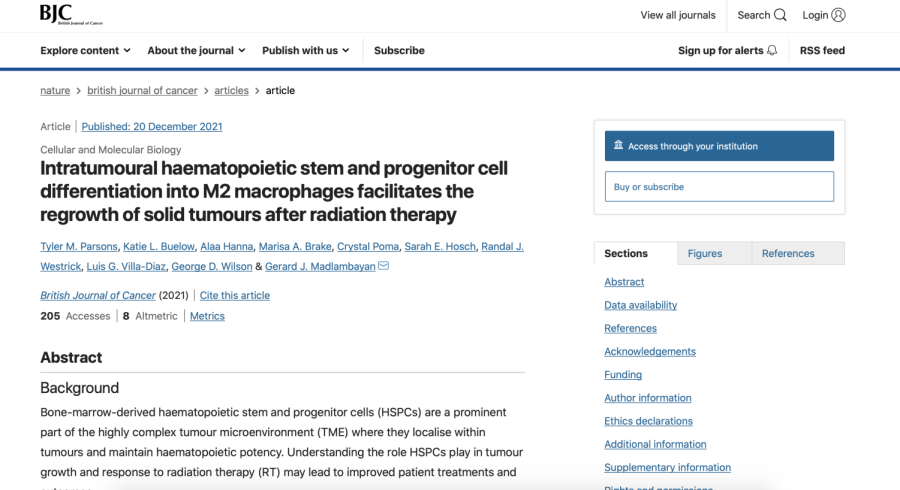OU-Beaumont Research could improve future cancer treatment
The findings could improve future cancer treatment.
Recent OU alumni, Tyler Parsons, Ph.D., in collaboration with OU faculty and Beaumont Research Institute, published research on blood stem cell relation to tumor growth in the British Journal of Cancer — presenting new findings that could improve future cancer treatment.
The project, “Intratumoural haematopoietic stem and progenitor cell differentiation into M2 macrophages facilitates the regrowth of solid tumors after radiation therapy,” was the first study to show that blood stem cells were utilized by tumors as a way to evade radiation treatment.
Gerard Madlambayan, Ph.D., associate professor of biological sciences and co-author of the study, states this project was a continuation of previous research conducted in his lab by former doctoral student at OU, Jonathan Kane.
Prior research conducted by Kane, Madlambayan and others showed that a population of blood stem cells migrated to tumors — specifically looking at lung carcinomas — after exposure to radiation. They also found that the higher the population of these cells in the tumor, the higher the probability the tumor would regrow after radiation.
Building off of these findings, Parsons, Madlambayan and several OU faculty members and investigators from the Beaumont Research Institute, hoped to identify how blood stem cells correlated to tumor growth. The research looked at cell differentiation or the process in which dividing cells change their functional type.
In this specific research study, the cell differentiation being analyzed involved how blood stem cells differentiated in the tumor to cause the growth.
The team discovered that a change in the microenvironment of the tumor could cause blood stem cells to turn into M2 macrophages, cells that allow the tumor to regrow. They also realized when the tumor was irradiated, the microenvironment produced stimulating colony factor 1, or CSF-1, which led to the hypothesis that the radiation was creating an environment that told the blood stem cells to differentiate themselves into M2 Macrophages.
Continuing to build off of their discoveries, Parsons and the research team began investigating how they could potentially block the blood stem cells from differentiating into M2 macrophages. They discovered by incorporating a drug that blocked the CSF-1, the tumor did not tell the blood stem cells to turn into M2 macrophages.
To test their CSF-1 inhibiting drug, the team used cells that glow red and radiated the tumor with these red-glowing cells in order to track them. Before adding the drug, the team recorded the cells changed into M2 macrophages, aiding the growth of the tumor. After blocking the CSF-1, they were able to decrease the number of M2 macrophages and the size of the tumors were significantly smaller.
In conjunction with clinical trials currently being conducted at Beaumont, the team tested two forms of radiation during their research. The first was the standard form of radiation commonly used in cancer treatments, and the second called hyperfractionated radiation, or radiation that is administered multiple times a day but in smaller doses.
Ultimately, the team recorded that the use of combination therapy between the CSF-1 inhibiting drug and radiation therapy caused the tumors to decrease dramatically. The combination worked well using standard radiation treatment doses and increments but worked even better using the hyperfractionated radiation treatment.
Madlambayan hopes this discovery will lead to improvements in standardized cancer treatments and, because the combination method worked well in the research process, he believes the hyperfractionated radiation, combined with the CSF-1 inhibiting drug could be extremely beneficial to the future of treatments. He also credits the university for allowing such research to take place.
“The environment that we have at Oakland University does allow for this kind of research, it allows us to interact not only in research labs but also with clinicians and allows this kind of translational research to be done at Oakland University,” Madlambayan said. “We’re not just a teaching institute, we do a lot of good research at Oakland and hopefully students see that and come into OU and do their graduate work or do some kind of research while they’re here.”
Parsons graduated from OU with his Ph.D. in Biological and Biomedical Sciences in the spring of 2021. He is currently working at Washington University School of Medicine in Saint Louis as a hematology-oncology postdoctoral research fellow in the Division of Oncology.






